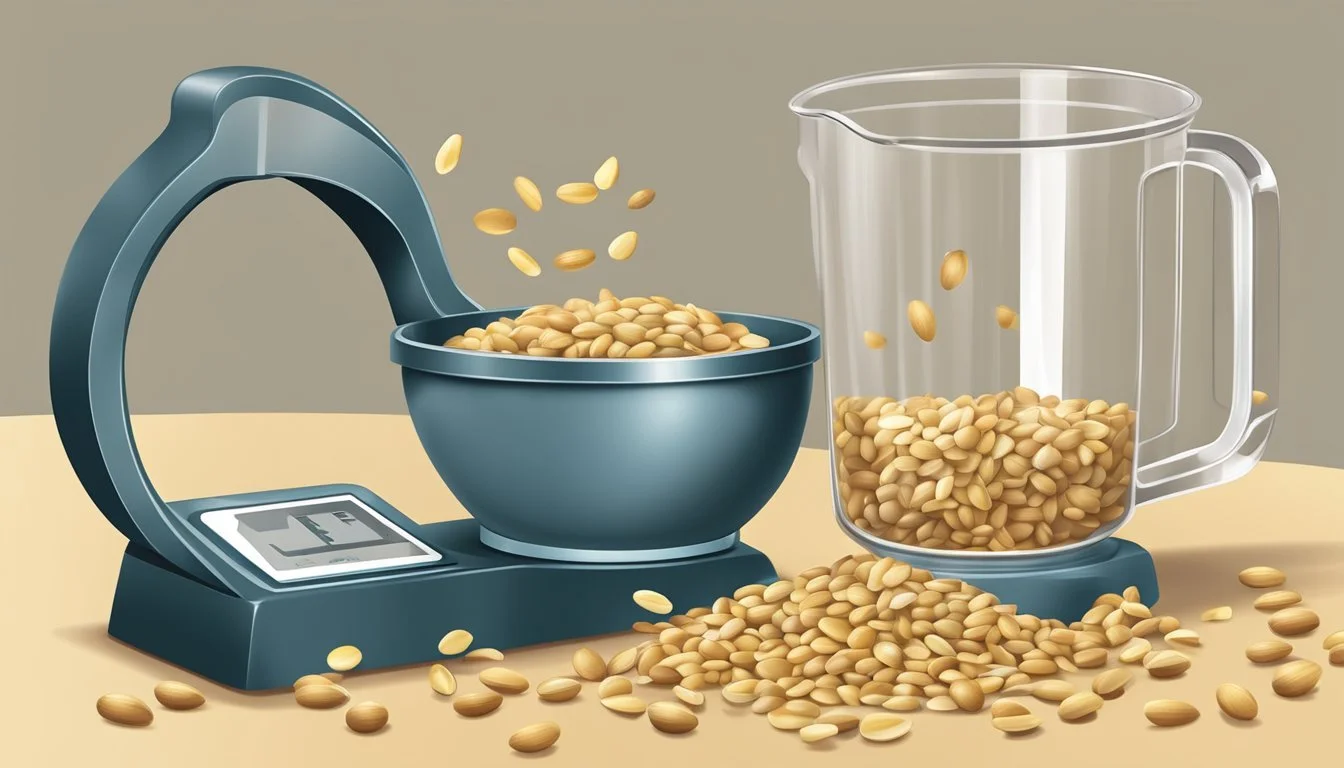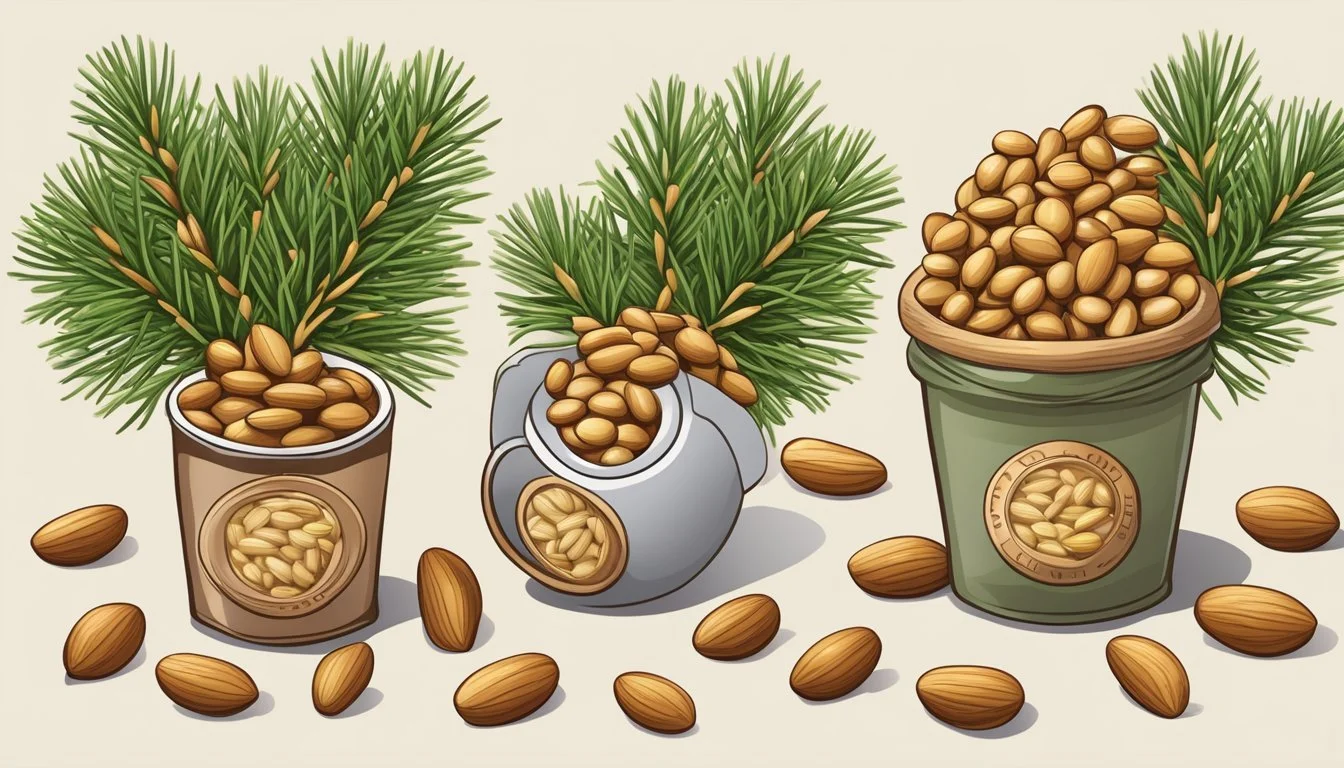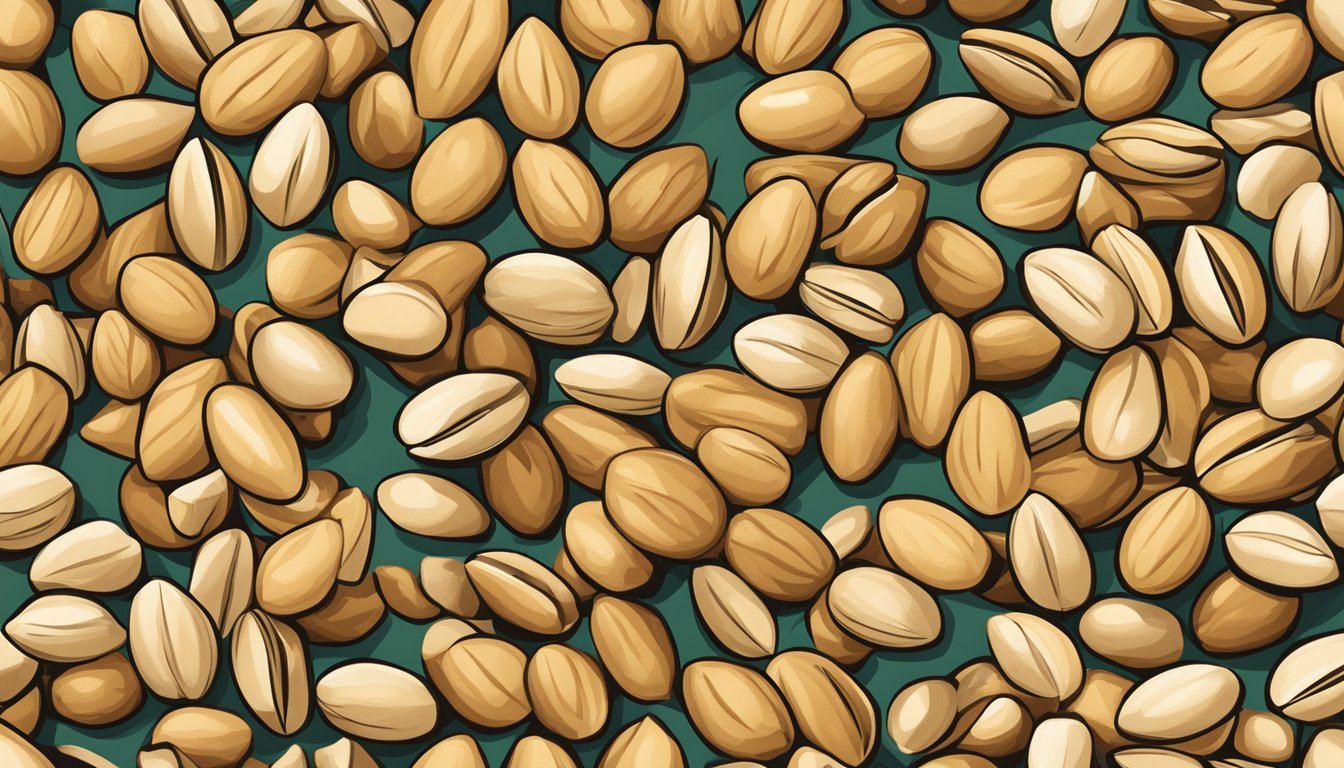How Many Cups in a Pound of Pine Nuts
Quick Measurement Guide
Determining the conversion of cups to pounds for pine nuts is useful for culinary enthusiasts, chefs, and home cooks alike. A standard US cup of dried pine nuts weighs approximately 4.8 ounces. Since there are 16 ounces in a pound, it would take a bit more than 3 cups of pine nuts to equal one pound. This measurement can vary slightly depending on the size and condition of the nuts, but for most recipes, this conversion provides a reliable estimation.
When working with pine nuts in the kitchen, it's important to consider both weight and volume. Weight is a more accurate measurement for dry ingredients like nuts, as the volume can be affected by the size of the individual nuts and how they settle in the measuring cup. For recipes that require precision, it is recommended to weigh the nuts rather than relying solely on volume measurements.
Converting from cups to pounds is particularly relevant when purchasing or using larger quantities of pine nuts. Whether in the shell or shelled, raw or toasted, pine nuts are a versatile ingredient commonly used in pesto, salads, and baked goods. Keeping this conversion in mind ensures that recipes are followed accurately, and the desired outcomes are achieved in various culinary preparations.
Nutritional Profile of Pine Nuts
Pine nuts boast a rich nutrient profile that offers an array of health benefits. Known for their high caloric value, which primarily comes from fats, an ounce of pine nuts contains about 188 to 191 calories.
The fats in pine nuts are predominantly unsaturated, which are beneficial to health. A one-ounce serving has approximately 19 grams of fat, with unsaturated fats constituting the major portion—9.5 grams of polyunsaturated and 5.3 grams of monounsaturated fats. Saturated fat is present, albeit in smaller quantities, at 1.4 grams.
While low in carbohydrates, pine nuts offer a good source of dietary fiber, with about 3.7 grams of carbohydrates and 1 gram of fiber per ounce. Sugars in pine nuts are minimal, typically around 1 gram per ounce.
In addition to fats and carbohydrates, pine nuts provide a modest amount of protein, with nearly 3.88 grams per one-ounce serving. They contribute to a balanced diet with a variety of nutrients, including essential vitamins and minerals. Pine nuts are a notable source of vitamin E and contain beneficial minerals that may support blood sugar stability and other aspects of health.
Nutrient Amount Per Ounce (Approx.) Calories 188-191 kcal Total Fat 19 g Saturated Fat 1.4 g Polyunsaturated Fat 9.5 g Monounsaturated Fat 5.3 g Carbohydrates 3.7 g Fiber 1.0 g Sugars 1.0 g Protein 3.88 g
This robust nutritional composition underscores the reputation of pine nuts as a healthy addition to various diets and culinary preparations.
Units of Measurement in Cooking
In cooking, precise measurement is paramount for achieving consistent outcomes, and recognizing the differences between weight and volume is essential. A clear understanding of the various units used in recipes can greatly impact the success of the preparation.
Understanding Weight and Volume
Weight measures an item's heaviness and is commonly expressed in ounces (oz), pounds (lb), grams (g), kilograms (kg), and milligrams (mg). In contrast, volume measures the space an item occupies, using units such as US cups (cup), milliliters (mL), liters (L), US tablespoons (tbsp), and US teaspoons (tsp). As density varies among ingredients, a cup of one substance will not weigh the same as a cup of another; for instance, a cup of feathers is lighter than a cup of lead.
Common Units in Food Recipes
Recipes often call for common volume measurements like teaspoons, tablespoons, and cups, especially for liquid ingredients or items that can be easily leveled off.
Volume Conversions:
1 US cup = 16 US tablespoons
1 US tablespoon = 3 US teaspoons
1 US cup = 8 fluid ounces
For ingredients that are dry or can be compacted, weight measurements provide more accuracy.
Weight Conversions:
1 pound (lb) = 16 ounces (oz)
1 ounce = approximately 28.35 grams (g)
1 kilogram (kg) = 1000 grams
In recipes, precision in converting these units is crucial for the integrity of the dish. As ingredients have different densities, conversion between weight and volume can vary; for example, a pound of pine nuts is roughly equivalent to 4 US cups. Understanding these conversions ensures the desired texture and flavor profile of the final product.
Converting Pine Nuts from Weight to Volume
When converting from weight to volume for pine nuts, precision is key, as it ensures accuracy in recipes and dietary considerations. Specific measurements can vary slightly depending on the size and cut of the nuts.
Pounds to Cups Conversion
To convert pounds to cups for pine nuts, one must consider the density of the nuts. Generally, a pound (lb) of pine nuts translates to approximately 4 cups. However, the exact number can differ slightly depending on the size and consistency of the nuts:
1 lb of pine nuts = ~4 cups (US Cup)
This conversion assumes that the pine nuts are whole. Finer or coarser cuts would alter the cup measurement because they change how much space the nuts occupy.
Converting Ounces to Milliliters
While ounces (oz) are a unit of weight and milliliters (ml) are a unit of volume, converting between them for pine nuts requires knowledge of the density of the nuts.
Here's a brief conversion table for pine nuts:
Ounces (oz) Grams (g) US Cups (approx.) 0.6 oz 15 g 1/8 cup 1.2 oz 30 g 1/4 cup 1.8 oz 45 g 1/3 cup
When recipes call for pine nuts in ounces and kitchen tools measure in milliliters, a converter tool or conversion chart becomes essential for accurate translation between these units. It's important to have a converter that accounts for the specific density of pine nuts if precision is necessary.
Practical Kitchen Conversions
In the kitchen, accuracy in converting measurements from cups to pounds is crucial, especially for ingredients like pine nuts where density plays a key role.
Using Kitchen Scales and Measuring Cups
For precise cooking and baking, kitchen scales are indispensable because they provide the most accurate measurement of weight. When using scales, one should place the measuring cup on the device before zeroing it out to ensure the weight of the cup isn't included in the final reading. One can then add the pine nuts until the scale reads the desired weight in pounds.
Conversion example:
For pine nuts: 1 cup is approximately equal to 0.3 pounds.
Measuring cups, on the other hand, measure volume. Since ingredients can settle or be of varying coarseness, measuring by volume isn't as precise as by weight, but it's commonly used for ingredients where exact precision is less critical.
Estimations and Approximations
When a kitchen scale is unavailable, approximations become necessary. General conversions can be relied upon for ingredients with consistent densities, such as water, where 1 cup equals approximately 0.52 pounds. However, with variable-density foods like pine nuts, these estimates are less reliable.
Conversion examples using the data:
Pine nuts:
1 1/4 cups ≈ 0.385 pounds
2 1/2 cups ≈ 0.769 pounds
3 3/4 cups ≈ 1.15 pounds
It's important for one to remember that these are approximations and the actual weight can vary based on factors such as size and moisture content of the food. When following recipes, if the ingredient list is in weights, it is preferable to use a scale. If the list is in cups or spoons and precision is less essential, measuring cups can suffice.
Usage of Pine Nuts in Recipes
Pine nuts, with their delicate, buttery flavor and creamy texture, are a versatile ingredient that can elevate both sweet and savory dishes. They are not only used in traditional recipes such as pesto but also can be a unique addition to numerous culinary creations.
Incorporating Pine Nuts in Sweet Dishes
In sweet recipes, pine nuts provide a subtle crunchy contrast to the soft textures often found in baked goods. They can be sprinkled on desserts like cakes and pastries to add a nutty flavor profile and visual appeal. In Italian baking, pine nuts are a staple atop pignoli cookies, which boast a chewy almond paste base. Bakers also incorporate toasted pine nuts into bread doughs to infuse a piney aroma and enrich the texture. When preparing sweet dishes, chefs often balance the sweetness level with the slightly resinous taste of pine nuts to achieve a sophisticated flavor harmony.
Savory Applications of Pine Nuts
Pine nuts are a cherished ingredient in savory dishes for their ability to complement and enhance flavors. These are some specific ways in which they are employed:
Pesto: Arguably the most iconic use of pine nuts, traditional pesto sauce combines these nuts with basil, Parmesan cheese, garlic, and olive oil.
Pasta: Toasted pine nuts can add depth to pasta dishes, either as part of a sauce or sprinkled on top as a garnish.
Salads: A handful of pine nuts contributes both texture and a creamy taste to salads, pairing well with robust greens and vinaigrettes.
Protein Dishes: Pine nuts can be added to the crust for beef fillets or mixed with ground meat for a richer flavor.
Cheese Pairings: Chefs often use pine nuts as a crunchy complement to soft cheeses in antipasto platters.
Their high oil content allows pine nuts to blend seamlessly into dressings and sauces, augmenting the mouthfeel and binding the diverse flavors present in the dish. It's important to note that pine nuts should be added towards the end of the cooking process to maintain their texture and prevent burning.
Nut Conversion Factors
When converting the weight of nuts to volume measurements like cups, the specific type of nut and its density are key factors. Different nuts have varying densities and sizes, which affect how they settle in a measuring cup.
Specifics for Common Nuts
Pine Nuts: Generally, 1 pound of pine nuts is equivalent to around 4 to 5 cups. This can vary slightly based on the size and exact density of the pine nuts.
Almonds: For almonds, 1 pound equates to approximately 3.5 cups when whole, and closer to 4 cups if chopped.
Walnuts: Whole walnuts measure about 3.25 cups per pound, while chopped walnuts yield approximately 4 cups per pound.
Peanuts: With peanuts, expect to get roughly 3.5 cups per pound if they are whole, and about 4.5 cups per pound when chopped.
Adjusting for Different Nut Types
The weight-to-volume conversion can differ greatly among various types of nuts due to their unique food density and size. To accurately measure nuts without a scale:
Consider the form of the nut (whole, sliced, chopped) as this alters the measurement.
Recognize that the same volume of different nuts may not equal the same weight due to density differences.
For example, denser nuts like almonds will weigh more than an equal volume of less dense nuts such as pine nuts. It's vital to consult specific conversion charts or reliable recipes when precise measurements are necessary for culinary success.
Food Data References
When it comes to accurate measurements in cooking, referencing reliable food data is essential. For converting volumes to weights, like cups to pounds, the U.S. Department of Agriculture (USDA) offers a trusted resource in its FoodData Central. This comprehensive food database provides detailed nutritional information, both for generic and branded foods, noted with universal product codes (UPCs), and managed by the Agricultural Research Service.
The conversion of pine nuts from cups to pounds can be found using this resource. A specific entry in the database might not exist for each potential conversion, but close approximations can often be made by analyzing similar data points.
Below is the conversion data extracted for pine nuts:
US Cups of Pine Nuts Weight (Pounds) 1 1/4 0.385 2 1/2 0.769 3 3/4 1.15 5 1.54
This table serves as a helpful guide for those looking to measure pine nuts accurately by weight. One must take into account that this conversion can vary slightly based on factors like the size and condition of the pine nuts, such as whether they are whole or chopped, and their level of moisture content when measured.
Leveraging FoodData Central, individuals can access a wide variety of food composition data. In addition to weight conversions, the database includes nutritional values such as calories, macronutrients breakdown, and micronutrient content, valuable for diet planning and nutritional analysis.
Advanced Topics in Cooking Measurements
In culinary arts, precise cooking measurements are vital for successful recipes. This section delves into the complexities of measuring ingredients at varying temperatures and converting from volume to mass, both crucial for consistent outcomes.
Cooking at Different Temperatures
Temperature has a significant impact on the mass and molar concentration of substances used in cooking. For instance, the mass of a cup of pine nuts could change slightly when measured at different temperatures due to expansion or contraction. Chefs must consider that a metric cup of pine nuts measured in a cold room will have a different mass compared to one measured at a higher temperature.
When creating dishes that require precise chemistry, like candies or jams, a cooking thermometer becomes an essential tool. Handling temperature-sensitive ingredients means knowing the exact boiling points and managing the stable molar concentration of the substances involved.
Volume to Mass Calculations
The conversion between volume and mass is critical, especially when using ingredients like pine nuts that don’t follow a standard conversion like many liquids do. For pine nuts, specific gravity, or the ratio of the density of the pine nuts to that of pure water, will affect the conversion rates, as specific gravity varies with temperature changes.
Cooking often requires conversions among various volume measurements like US pints, US quarts, and US gallons. A converter is a tool that can help with these calculations, but it is essential to account for the specific gravity of the ingredient if you're converting volume to mass:
1 US pint = 2 cups
1 US quart = 4 cups
1 US gallon = 16 cups
1 Imperial gallon is approximately 1.2 US gallons
For solid ingredients, chefs must calculate the volume based on the shape of the ingredient or its container, whether it's cylindrical or rectangular shaped. A measurement from a cylindrical container such as a measuring cup might yield a different mass compared to a quarter cylindrical or scooped measure. Precision in these conversions ensures the consistency and desired outcome of a recipe.









